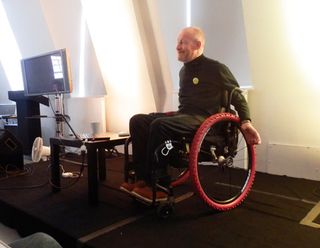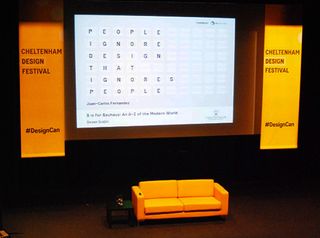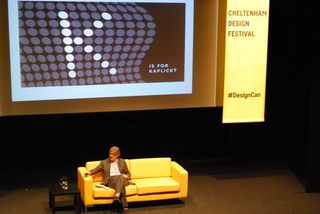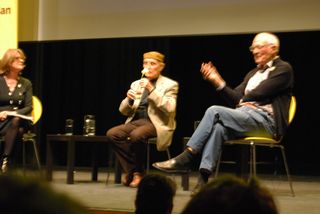Why great design can overcome anything
A diverse programme on day two of Cheltenham Design Festival featured themes of authenticity, substance and innovation in the face of adversity.
Having explored the theme of design as an agent for positive change on day one, the second day of Cheltenham Design Festival expanded the field of discussion to include everything from spacecraft engineering to wheelchair design in third-world countries – proving that insight and inspiration can (and should) come from anywhere.
There was also plenty of creative energy and thought-provoking discussion from inimitable graphic design icon Ken Garland, revered industrial designer Sir Kenneth Grange and Deyan Sudjic, director of London's Design Museum.
Inspiration from unusual places
The day began with a fascinating whistle-stop tour of events since the Big Bang, followed by an exploration of the design challenges faced on two recent space missions. Delivered by Rutherford Appleton Laboratory's Chris Bee in the main Auditorium, Design for the Cosmos shared a common theme with the talk that followed from David Constantine: innovation in the face of adversity.
Co-founder of design consultancy Motivation – which strives for "freedom through mobility" – Constantine gave an incredibly inspiring session in the festival's smaller Studio venue that began with the story of how, as a youth, he dived into a shallow pool while holidaying in Australia and broke two vertebrae in his neck, permanently paralysing himself from the chest down.

Most of the session focused on how a student brief that he received at the RCA – to design a wheelchair for the developing world – set the cogs in motion for a decade of design innovation in the field solving very different challenges in the far-flung corners of the planet, from Bangladesh to Nicaragua.
While Bee's challenges included such high-level concerns as how to engineer a component to a tolerance of one micron (a thousandth of a millimetre) and develop a telescope that could assemble itself 1.5 million kilometres from Earth in minus 273 Celsius, Constantine's innovations included overcoming lack of materials and poor transport in Cambodia in 1993 to create a wooden, flat-packed wheelchair.
Both were fascinating and inspiring in equal measure for any designer faced with a seemingly insurmountable problem.
Get the Creative Bloq Newsletter
Daily design news, reviews, how-tos and more, as picked by the editors.
An alphabet of influences
Later in the afternoon, Deyan Sudjic settled himself comfortably into the festival’s emblematic yellow sofa to walk a packed Auditorium through some of the varied and enlightening touchpoints explored in his book B is for Bauhaus.

It all started, as any alphabet should, with A – for Authentic. Sudjic recalled how the parka he once owned had a distinctive brass zip and "reeked of authenticity”, a desirable quality that all-too often designers try to “lovingly fake” rather than actually deliver.
After an entertaining journey that skipped through some letters, and dwelled on others with several examples, he came full circle with 'Z is for Zip', an example of how great design isn’t always about one superstar designer taking all the credit. “Design is sometimes about anonymity: many small steps, many people working on a project,” he said. “There’s such a thing as a humble masterpiece."

Perhaps the highlight of the session, however, was a probing and slightly mischievous question from Ken Garland in the audience, who asked what the thinking was behind the Design Museum putting on a huge Dieter Rams exhibition versus a much smaller, and by Sudjic’s own prior admission, badly-delivered show on ergonomics.
The answer explored the serious relative value of each, but also admitted that sometimes things don’t go to plan, with the example of an unfortunate typo labelling CERN’s famed Swiss-based particle research facility the ‘Hardon Collider’.
An entertaining meeting of minds
Never without a twinkle in his eye, Garland was a regular sight throughout the day – and hosted an afternoon session in the Studio on the enduring relevance of E.F Schumacher’s 1973 book Small is Beautiful, which involved handing out assorted pebbles to the audience to help illustrate his point.
He returned to the stage in the evening alongside another design legend, Sir Kenneth Grange – a founding partner of Pentagram, with a prolific industrial design career spanning everything from food mixers and razors to high speed trains.

It was an unmissable and hugely entertaining meeting of great minds, punctuated every so often by Garland reaching for the flower vase on the table beside him and taking a sip from the water in a comic turn that delighted the audience.
The loose theme was Standing on the Shoulders of Giants: Garland spoke of building on the legacy of ‘non-designers’ such as William Blake and Mary Wollstonecraft, while Grange took a more pragmatic view: "We stand on the shoulders of our clients," he mused, prompting Garland to add with a smile: "Sometimes my clients accuse me of standing on their crotch."
What next for design?
Themes such as the importance of education and literacy, international influences and style over common sense were all chewed over by the two Kens, with Grange accusing Apple of being increasingly guilty of the latter. "Designers have been sucked into style as the principal nature of a product," he said. "It retreats further and further from common sense, and draws a line between old farts and medium farts."
Following a series of witticisms that kept the Auditorium chuckling, Ken Garland became serious when asked about the state of design education: "I've seen more potential in young people in the last 10 years than I have over the previous 40," he declared. "Students inspire me, not the other way around."
With so much talent coming up through the ranks, both men agreed that the future looks bright for design – but Garland returned to mischievousness for a moment to add that the future of the world itself perhaps isn’t quite so positive: "We're going to blow ourselves up in the next 30 years anyway."
Computer Arts will be bringing you a full event report in issue 227 of the magazine, so stayed tuned.
Words: Nick Carson
Nick is editor of Computer Arts' print and digital editions. He's worked on the brand for five years, having previously edited sister titles CA Collection and CA Projects.

Thank you for reading 5 articles this month* Join now for unlimited access
Enjoy your first month for just £1 / $1 / €1
*Read 5 free articles per month without a subscription

Join now for unlimited access
Try first month for just £1 / $1 / €1
The Creative Bloq team is made up of a group of design fans, and has changed and evolved since Creative Bloq began back in 2012. The current website team consists of eight full-time members of staff: Editor Georgia Coggan, Deputy Editor Rosie Hilder, Ecommerce Editor Beren Neale, Senior News Editor Daniel Piper, Editor, Digital Art and 3D Ian Dean, Tech Reviews Editor Erlingur Einarsson and Ecommerce Writer Beth Nicholls and Staff Writer Natalie Fear, as well as a roster of freelancers from around the world. The 3D World and ImagineFX magazine teams also pitch in, ensuring that content from 3D World and ImagineFX is represented on Creative Bloq.
